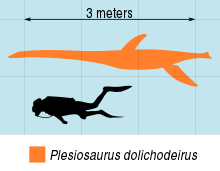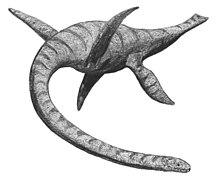Plesiosaurus
| Plesiosaurus | |
|---|---|

| |
| Restored skeleton in Japan | |
| Scientific classification | |
| Domain: | Eukaryota |
| Kingdom: | Animalia |
| Phylum: | Chordata |
| Class: | Reptilia |
| Superorder: | †Sauropterygia |
| Order: | †Plesiosauria |
| Superfamily: | †Plesiosauroidea |
| Family: | †Plesiosauridae |
| Genus: | †Plesiosaurus Conybeare , 1821
|
| Species: | †P. dolichodeirus
|
| Binomial name | |
| †Plesiosaurus dolichodeirus Conybeare, 1824
| |
Plesiosaurus (Greek: πλησίος (plesios), near to + σαῦρος (sauros), lizard) is a genus of extinct, large marine
Discovery
The first complete skeleton of Plesiosaurus was discovered by early paleontologist and fossil hunter Mary Anning in Sinemurian (Early Jurassic)-age rocks of the lower Lias Group in December 1823.[1][2] Additional fossils of Plesiosaurus were found in rocks of the Lias Group of Dorset for many years,[3][4][5] "until the cessation of quarrying activities in the Lias Group, early in this [20th] century."[2] although less complete remains were used by Henry De la Beche and William Conybeare to name the species two years earlier in 1821,[6] and despite being discovered first, Conybeare's remains were not the holotype; Anning's were.
Plesiosaurus was one of the first of the "
Description
Skull and dentition

Compared to other plesiosaur genera, Plesiosaurus has a small head. The skull is much narrower than long,
The two
The teeth of Plesiosaurus are "simple, needle-like cones" that are "slightly curved and circular in transverse section". They are sharply pointed with fine striations running from tip to base, and point forward (procumbent). This procumbency becomes more pronounced near the leading end of the skull, where they may be only 10–15° above horizontal.[7] There are 20 to 25 teeth per upper jaw tooth row,[8] and 24 per low jaw tooth row.[7] Up to four teeth of a lower jaw's tooth row are found in the symphyseal region.[12]
Vertebral column

Plesiosaurus was a moderately sized plesiosaur that grew to 2.87–3.5 m (9.4–11.5 ft) in length.
Ribs are found from the neck to the tail. Cervical ribs are hatchet-shaped and have two articular heads.
Limbs
The shoulder girdle is only partly known but appears to be typical for plesiosaurs. It includes fused
The pelvis includes equant pubic bones, ischia,[18] and blade-shaped ilia connecting the pelvis to the vertebral column.[19] The acetabulum is formed by surfaces on the pubic bones and ischia. Similar to the pectoral girdle, there is a pair of holes between the ischia and pubic bones.[18] The hindlimbs are long and narrow,[19] and in adults, they are much smaller than the forelimbs.[18] The thigh bones are straight. The lower hindlimb includes two roughly equal-sized bones, the robust tibia and the semilunate-shaped fibula. There are six bones in the ankle. The foot paddle includes five digits. Like the hand, the phalangeal formula is uncertain, but is at least 3-7-9-8-7 from innermost to outer "toe".[19]
Classifications



Plesiosaurus has historically been a
The following cladogram follows an analysis by Benson et al., 2012, and shows the placement of Plesiosaurus within Plesiosauria.[20]
Palaeobiology

Plesiosaurus fed mainly on clams and snails, and is thought to have eaten
Palaeoenvironment

Unequivocal specimens of Plesiosaurus dolichodeirus are limited to the Lyme Regis area of Dorset.
See also
References
Notes
- ^ Torrens 1995
- ^ a b c Storrs 1997 pp. 146
- ^ Andrew 1896
- ^ Lydekker 1889
- ^ Owen 1865
- ^ a b De la Beche, H. T. & W. D. Conybeare. (1821). Notice of the discovery of a new fossil animal, forming a link between the Ichthyosaurus and crocodile, together with general remarks on the osteology of the Ichthyosaurus. Transactions of the Geological Society of London 5: 559–594
- ^ a b c d e f Storrs 1997 pp. 166
- ^ a b c d e f g h i j k Storrs 1997 pp. 165
- ^ a b Storrs 1997 pp. 167
- ^ Cruickshank 1991
- ^ Taylor and Cruickshank 1993
- ^ a b Storrs 1997 pp. 169.
- S2CID 129977015.
- ^ Storrs 1997 pp. 149
- ^ a b c d e Storrs 1997 pp. 170
- ^ a b c Storrs 1997 pp. 171
- ^ Storrs 1997 pp. 173
- ^ a b c d Storrs 1997 pp. 176
- ^ a b c Storrs 1997 pp. 178
- PMID 22438869.
- ^ "Plesiosaur bottom-feeding shown". 17 October 2005.
- ^ "Sticking your neck out: How did plesiosaurs swim with such long necks?".
- ^ Storrs 1997 pp. 148
- ^ Storrs 1997 pp. 179
- ^ Storrs 1997 pp.180
Sources
- Andrews, C. W. 1896. "On the structure of the plesiosaurian skull". Quarterly Journal of the Geological Society, London, 52, 246–253.
- Brown, D. S. 1981. "The English Upper Jurassic Plesiosauroidea (Reptilia) and a review of the phylogeny and classification of the Plesiosauria". Bulletin of the British Museum (Natural History): Geology, 35, (4), 253–347.
- Cruickshank, A. R. I.; Small, P. G.; and Taylor, M. A. 1991. "Dorsal nostrils and hydrodynamically driven underwater olfaction in plesiosaurs". Nature, 352, 62–64.
- Lydekker, R. 1889. Catalogue of the fossil Reptilia and Amphibia in the British Museum (Natural History), Part II. Containing the Orders Ichthyopterygia and Sauropterygia. British Museum (Natural History)
- Richard Owen, Fossil Reptili of the Liassic Formations, pt iii. (Monogr. Palaeont. Soc., 1865)
- Persson, P. O. 1963. A revision of the classification of the Plesiosauria with a synopsis of the stratigraphical and geographical distribution of the group. Lunds Universitets Årsskrift, N. F. Avd. 2. 59, 1–59.
- Storrs, G. W. 1991. "Anatomy and relationships of Corosaurus alcovensis (Diapsida: Sauropterygia) and the Triassic Alcova Limestone of Wyoming". Bulletin of the Peabody Museum of Natural History, 44, 1–151.
- Storrs, G. W. and Taylor, M. A. 1996. "Cranial anatomy of a new plesiosaur genus from the lowermost Lias (Rhaetian/Hettangian) of Street, Somerset, England". Journal of Vertebrate Paleontology, 16, (3), 403–420.
- Storrs, G. W. 1997. "Morphological and taxonomic clarification of the genus Plesiosaurus". 145–190. In Callaway, J. M and Nicholls, E. L. (eds.). Ancient Marine Reptiles. Academic press. London.
- Taylor, M. A. and Cruickshank, A. R. I. 1993. Cranial anatomy and functional morphology of Pliosaurus brachyspondylus (Reptilia: Plesiosauria) from the Upper Jurassuc of Westbury, Wiltshire. Philosophical Transactions of the Royal Society of London, Series B, 341, 399–418.
- Torrens, Hugh 1995. "Mary Anning (1799–1847) of Lyme; 'The Greatest Fossilist the World Ever Knew'". The British Journal for the History of Science, 25 (3): 257–284
External links
- Genus Plesiosaurus – The Plesiosaur Directory
- Plesiosauroidea – Palaeos
- Plesiosauria – Mikko's Phylogeny Archive
